Paul Hammant's Blog:
What is Your Branching Model?
Update: See the new resource site for Trunk-Based Development called, err, TrunkBasedDevelopment.com and make sure to tell your colleagues about it and this high-throughput branching model.
Note: At no point are we asking about local branching (on your local workstation with Git, etc). This is all about branching on the remote repository. That is if your company has one, and isn’t completely distributed, with no central repo.
Mainline
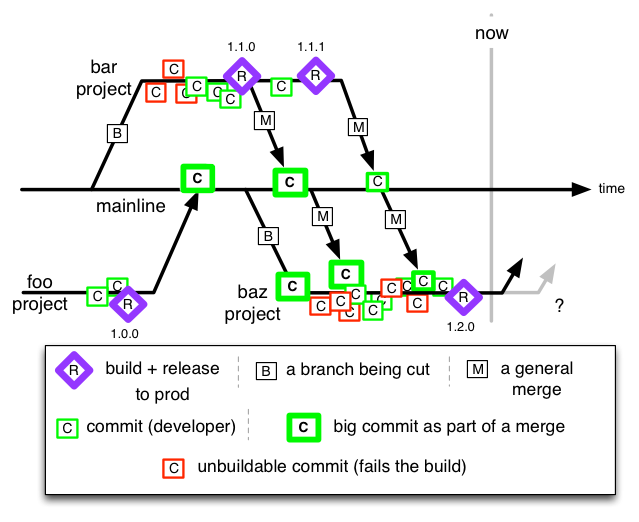
Teams develop on their own branches, and release from them. The then merge back to ‘mainline’ after the release. Many developers co-exist on one branch that can last for months, and that’s how major projects are separated. Some branches can be shorter in time than others. Sometimes one ‘in-flight’ branch receives interim merges from another in-flight one, despite the intention to merge from mainline exclusively when it’s been updated (after release).
IBM/Rational’s ClearCase really promoted this from 1998 through 2008. Nobody ever got fired for buying IBM.
Cascade
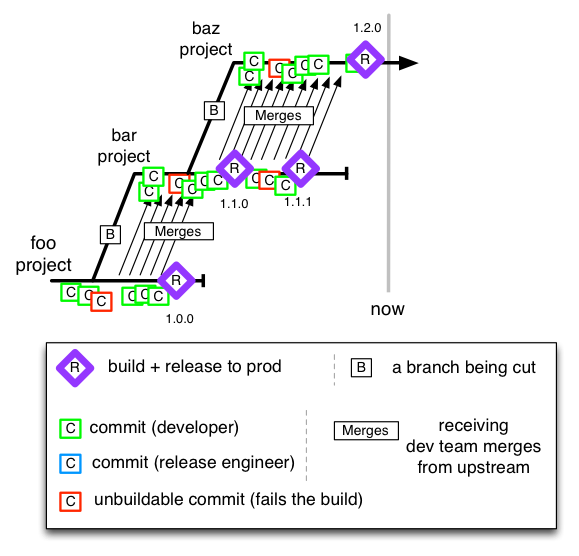
Project teams develops on their own branch and release from there when complete. Following releases (for separate projects on the same codebase) are on a branch from taken from the one before. The ‘downstream’ team merges as frequently as they can from the “upstream” branch. It’s a way of handling concurrent development of consecutive releases, but there’s a considerable cost of merge and an even bigger cost of un-merge (of you change the order of major releases).
I’ve only ever seen this once, so I don’t know how prevalent it is. I advised a change to trunk based development, and that paid off shortly after.
Trunk-Based Development
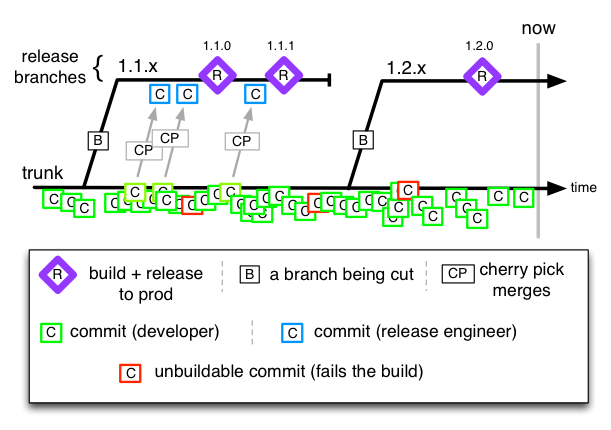
All project teams develop on a single trunk. Branches happen for releases only (only if a tag was not enough), with cherry-picks TO the release branch for defect-fixes. Teams probably use Feature Toggles, and Branch by Abstraction too in order to fit that concurrent development of consecutive releases goal.
If you didn’t know already I greatly favor this one in the enterprise.
I prefer that production defects are reproduced on the trunk, and merged to the release branch, but there are many that disagree.
Perforce from the middle 90’s and Subversion from 2001 promoted a trunk model, although neither preclude other branching models. Google have the world biggest Trunk-Based-Development setup, although some teams there are going to say they are closer to Continuous Deployment (below). Facebook are here too.
Short Lived Feature Branches
Allegedly short lived - there’s a risk of the Feature Branches morphing into the ‘Mainline’ prophesy (above).
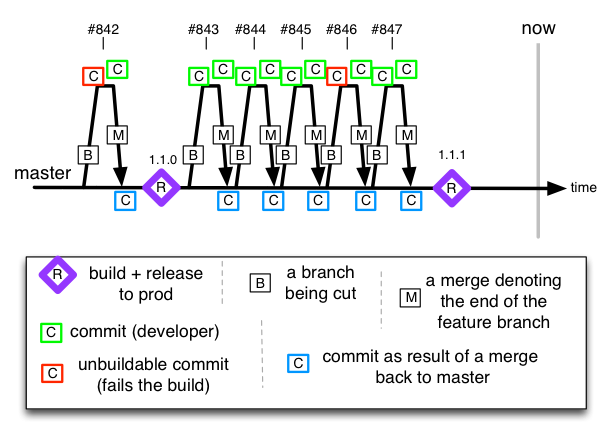
All developers make their own feature branches on the remote, work there, and merge back to master after a couple of days “tops”, when they have finished. They then delete the feature branch. This is not unlike doing the same practice on your local-workstation (local branches as Git promotes), but when they are pushed up the canonical repo, there’s a potential for sharing, and indeed help completing the feature. You could even hook up CI to those short-lived branches automatically to guard temporary the value they represent.
Continuous Deployment
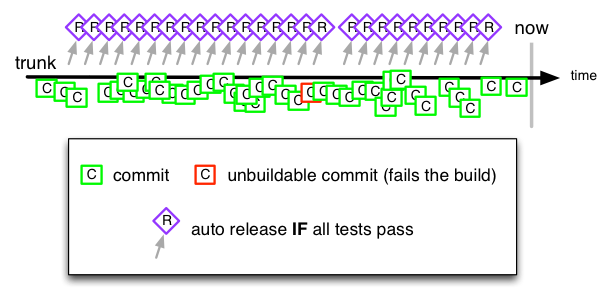
Commits can go all the way to production from one trunk/master, if the automated build says the commit was good. It’s the turbo-switch for TBD, where no humans can hold up a release by taking their sweet time testing it and giving a belated seal of approval. Github, Etsy, Netflix (and many more startups) are all here.
Subversion noise on branching
When Subversion came out it was suggested that “lightweight branching” was one of the benefits over CVS. When Git came out it was suggested that “lightweight branching” was the benefit over Subversion. Who was right? I think the Subversion branch-creation process is quite noisy - it marks every line as an add, when (versus the trunk) it was not like that. In the diagrams above, I’ve used C in a square to denote a commit, and made the size of the square the size of the commit (implies complexity/noise). Really for Subversion there’s a commit that’s sizable that comes with branch-creation and worth it’s own visualization, even in the TBD model that I prefer:
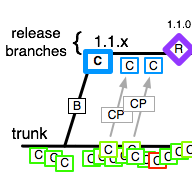
Git and Perforce (as you make a branch) don’t have that weight of commit. Here’s the filed issue - not sure whether the Subversion leads will agree.
More Notes
The Perforce people in their 1998 PDF “High-level Best Practices in Software Configuration Management”, presented that “trunk” and “mainline” were the same thing. They did now know then that Rational, around the same time, was going to forever cast Mainline as something else. They also don’t have this PDF on their site any more, which is a pity. You can still find it in Google, unless they go through a DMCA takedown exercise :-(
Comments formerly in Disqus, but exported and mounted statically ...
| Thu, 05 Dec 2013 | Ben Reser |
Paul, some thoughts on your comments about SVN. First of all the issue you found is really just an error in the calculation of the base of the diff, resulting in a display error. We have the info to correctly display the diff (as you can see when I rooted the diff at the branch in my response on the issue). I can't think of a good reason why it's behaving that way. There's no reason whatsoever for a diff to provide different results based on where you root it (other than excluding things above the root). The difference between "lightweight branching" that Subversion advertised over CVS vs the "lightweight branching" that Git advertises over SVN is that really the projects are talking about very different things. Subversion is talking about lightweight from the perspective of much simpler to use and from copy on write perspective. Git is talking about not even needing write access on the server to create a branch. Personally, I don't find git's branches any easier to use (though I'll fully admit I know the limitations of SVN and how to avoid them) other than the fact that you always have access to branching capabilities. I've certainly seen my share of problems using branches in both. Wasn't that long ago that I had to cleanup a situation where another contributor on a project I work on, that is using git, created a loop in branches that would have broken future merging. | |
| Fri, 06 Dec 2013 | paul_hammant |
I agree with what you say Ben. | |
| Fri, 06 Dec 2013 | Mohan Radhakrishnan |
Is there a collection of these approaches somewhere ? The version control ideas don't seem to be in any book. | |
| Fri, 06 Dec 2013 | paul_hammant |
Brad Appleton used to have a bunch of SCM patterns and anti-patterns somewhere, but I can't find them anymore. | |
| Thu, 12 Dec 2013 | Andre Ramaciotti |
I've found something: http://hillside.net/plop/pl.... Is this what you were looking for? | |
| Thu, 26 Dec 2013 | Mohan Radhakrishnan |
Yes. I used to read Brad Appleton. But there might be some new developments related to tools like Github. | |
| Fri, 25 Apr 2014 | Brad Appleton |
My "Streamed Lines" paper is at http://acme.bradapp.net/bra... | |
| Thu, 19 Dec 2013 | Craig Boland |
Brad Appleton's book: | |
| Mon, 12 May 2014 | Brad Appleton |
Hmmn - I found the 1998 PDF "High-level Best-Practices" paper by going to the perforce.com site and typing the name into their site-search. It came up with http://www.perforce.com/sit... | |